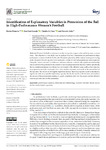Identification of Explanatory Variables in Possession of the Ball in High-Performance Women’s Football

Use this link to cite
http://hdl.handle.net/2183/28363Collections
- Investigación (CCDEF) [297]
Metadata
Show full item recordTitle
Identification of Explanatory Variables in Possession of the Ball in High-Performance Women’s FootballDate
2021-05-31Citation
Maneiro, R.; Losada, J.L.; Casal, C.A.; Ardá, A. Identification of Explanatory Variables in Possession of the Ball in High-Performance Women’s Football. Int. J. Environ. Res. Public Health 2021, 18, 5922. https:// doi.org/10.3390/ijerph18115922
Abstract
[Abstrac] Women’s football is a phenomenon that is experiencing an unstoppable increase in recent years. The objective of this study was to analyze how ball possessions are performed in highperformance women’s football. For this, the 52 matches played by all the national teams participating in the Women’s World Cup 2015 were analyzed. A total of 3740 ball possessions were examined. Using the “move outcome” variable as a reference criterion, a statistically significant relationship was found between possessions that ended in success and possessions that have failed. Specifically, the successful possessions were those that were made in the offensive zone, with a clear intention to progress towards the rival goal, with a low number of passes, and made in the second half of the matches. The results of the logistic regression showed that the proposed model is statistically significant, with an acceptable explanatory capacity. Finally, the results of the decision tree evidence the success of those possessions aiming at a quick completion, with very few passes and the offensive zone as a priority area for the possession.
Keywords
Performance analysis
Observational methodology
Women's football
Female soccer
Decision trees
Logistic regression
Análise do rendemento
Metodoloxía observacional
Fútbol feminino
Árbore de decisión
Regresión loxística
Observational methodology
Women's football
Female soccer
Decision trees
Logistic regression
Análise do rendemento
Metodoloxía observacional
Fútbol feminino
Árbore de decisión
Regresión loxística
Editor version
Rights
Atribución 4.0 Internacional
ISSN
1660-4601






